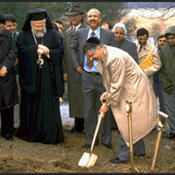 Congregations of different backgrounds live side-by-side in cities across the United States. Many take their proximity as an invitation to share resources and to learn about each other’s traditions. They may use the same buildings for worship, plan regular social meetings, and engage in activism motivated by their respective beliefs.
Congregations of different backgrounds live side-by-side in cities across the United States. Many take their proximity as an invitation to share resources and to learn about each other’s traditions. They may use the same buildings for worship, plan regular social meetings, and engage in activism motivated by their respective beliefs.
While violence is much more likely to make the newspapers, many stories of local cooperation and bridge-building between people of different religious traditions are not so well known. These people are not necessarily members of an interfaith organization, nor of any defined social movement; they are simply neighbors who have created new bonds of interfaith relations at the local level, and have joined together to create new community initiatives.
In May of 1991 in New York City, the roof of an active upper West Side synagogue, B’nai Jeshurun, caved in, rendering its Jewish congregation homeless. The neighboring St. Paul and St. Andrew’s United Methodist Church invited the congregation to share its space. The Jewish community began to worship in the huge sanctuary on Friday nights, while the Christians worshipped on Sunday mornings. Both congregations worshipped under the banner they hung in the sanctuary together, bearing the words of Psalm 133: “How good it is when brothers and sisters dwell together in harmony.” Over time, the communities shared more than space; they began to share a common journey, and a common commitment to the problems of the city and of the world. Today, B’nai Jeshurun has grown in size, regrouped, and opened a second location on their own—but congregants continue to meet in the Church of St. Paul and St. Andrew. B’nai Jeshurun and the Church of St. Paul and St. Andrew have also opened together a homeless shelter, at which both Jewish and Christian volunteers provide fresh meals for any neighbors experiencing homelessness.
In 1993, on a rainy spring day in New England, a ground-breaking in Sharon, Massachusetts brought together Jews, Christians, and Muslims from around Greater Boston. On a hillside overlooking the fields of a former horse pasture, rabbis and priests, imams and Muslim community leaders each turned a shovel of earth for the new Islamic Center of New England. The Islamic Center had suffered several setbacks in the previous two years, including an arson attack and an unsuccessful struggle in a nearby town to purchase land for the new center. At last, Sharon, Massachusetts—a suburban community with a population more than half Jewish—extended a hand of welcome to the Muslims. The transformation of a 54-acre former farm into a vibrant center of Islamic education, community life, and prayer is a story of grassroots cooperation.
Across the country in Fremont, California, two weeks after the groundbreaking in Sharon, St. Paul’s United Methodist Church and the Islamic Society of the East Bay broke ground together for a new church and a new mosque, to be built side by side. The two communities met on the day they bought adjacent lots of property being auctioned by the city. As each community laid plans for building, they found each could build a larger facility if they cooperated in common parking, landscaping, and lighting. They came to know each other in working out their complex set of easements and agreements with the city. “The city of Fremont married us,” remarked one of the Christian leaders. The communities named their common access road “Peace Terrace.” As one of the Muslim leaders said, “We want to set an example for the world.” Now, both buildings are completed and St. Paul’s United Methodist Church and the Islamic Society of the East Bay continue to work together. An example of the two communities’ commitment to ongoing collaboration is their co-hosting of an interfaith health fair in 2012 that provided free eye, dental, and blood pressure examinations for the low- or under-insured residents of Fremont.
These are but three striking examples of new patterns of religious cooperation that have born fruit from the very soil of America’s new religious landscape. There are many others, some of which have grown into interfaith organizations and ongoing initiatives. In Western Massachusetts, the Weston-Wayland Interfaith Action Group (WWIAG) formed as a response to anti-Semitic graffiti at the local high school in 1989, and today includes grassroots community improvement projects, potluck dinners, and interfaith memorial services. In Kansas City, theatre brings together different cultural communities through the one-act play, “The Hindu and the Cowboy.” In Omaha, Nebraska, Project Interfaith’s RavelUnravel showcases local stories of neighbors encountering one another and their differences, reflecting on what it means to be a resident of Omaha. After the tragedies of September 11, Syracuse, New York became home to Women Transcending Boundaries, a community-based women’s group dedicated to inter-religious programming, including an “Acts of Kindness” weekend featuring volunteer projects around the city. These stories and more profiled in America’s Interfaith Infrastructure, a pilot study of interfaith initiatives published by the Pluralism Project in 2012.